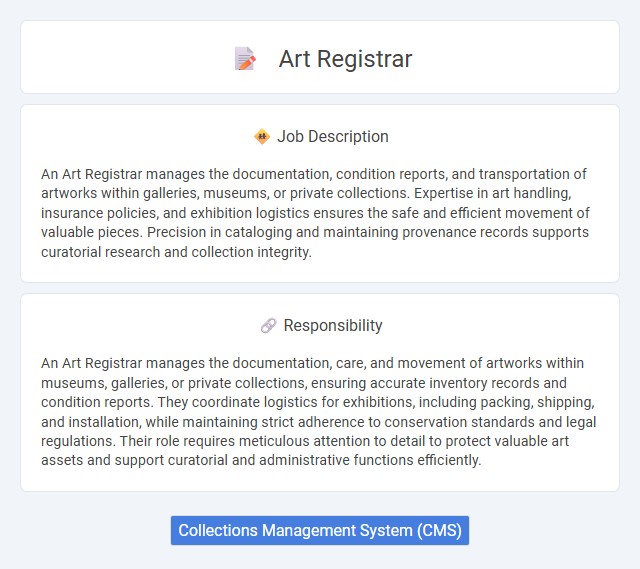
An Art Registrar manages the documentation, condition reports, and transportation of artworks within galleries, museums, or private collections. Expertise in art handling, insurance policies, and exhibition logistics ensures the safe and efficient movement of valuable pieces. Precision in cataloging and maintaining provenance records supports curatorial research and collection integrity.
Individuals with strong organizational skills and a keen eye for detail will likely thrive as art registrars, given the meticulous nature of managing collections and documentation. People who are comfortable working in structured environments and handling both physical artworks and digital records probably find this role suitable. Those who prefer dynamic, hands-on artistic creation may find the administrative aspects less engaging, suggesting a likelihood of mismatched job satisfaction.
Qualification
An Art Registrar must possess a bachelor's degree in Art History, Museum Studies, or a related field, with advanced knowledge of collection management systems and preservation standards. Strong organizational skills and experience in cataloging, documentation, and condition reporting are essential for maintaining accurate records of artwork provenance and condition. Proficiency in digital database software and familiarity with legal and ethical guidelines in art handling significantly enhance job performance.
Responsibility
An Art Registrar manages the documentation, care, and movement of artworks within museums, galleries, or private collections, ensuring accurate inventory records and condition reports. They coordinate logistics for exhibitions, including packing, shipping, and installation, while maintaining strict adherence to conservation standards and legal regulations. Their role requires meticulous attention to detail to protect valuable art assets and support curatorial and administrative functions efficiently.
Benefit
An Art Registrar job may offer benefits such as enhanced organizational skills and expertise in managing valuable collections, which could increase career prospects in museums and galleries. Employees might gain opportunities for networking within the art world, potentially leading to professional growth. The role likely provides a sense of fulfillment by contributing to the preservation and documentation of cultural heritage.
Challenge
An art registrar job likely involves managing complex logistics and detailed documentation for valuable artworks, which can present significant organizational challenges. The role probably requires balancing strict security protocols with timely access for exhibitions, thereby demanding meticulous attention to detail and problem-solving skills. Navigating the coordination between artists, curators, and transport firms may also pose ongoing communication and operational difficulties.
Career Advancement
An Art Registrar plays a crucial role in managing and documenting art collections, providing extensive knowledge of art handling, cataloging, and collection care. Career advancement opportunities include progressing to roles such as Collections Manager, Curator, or Museum Director, which require expanded responsibilities in acquisitions, exhibition planning, and strategic collection management. Mastery in database systems, provenance research, and preservation techniques significantly boosts prospects for leadership positions within galleries, museums, and cultural institutions.
Key Terms
Collections Management System (CMS)
An Art Registrar specializing in Collections Management System (CMS) plays a crucial role in maintaining accurate records of an institution's art collections, ensuring efficient cataloging, provenance tracking, and condition reporting. Expertise in CMS platforms such as TMS (The Museum System) or PastPerfect enables seamless integration of acquisition, loan, and exhibition data, supporting both physical and digital asset management. Detailed knowledge of metadata standards and database management optimizes accessibility and preservation of artworks for curators, conservators, and researchers.
 kuljobs.com
kuljobs.com